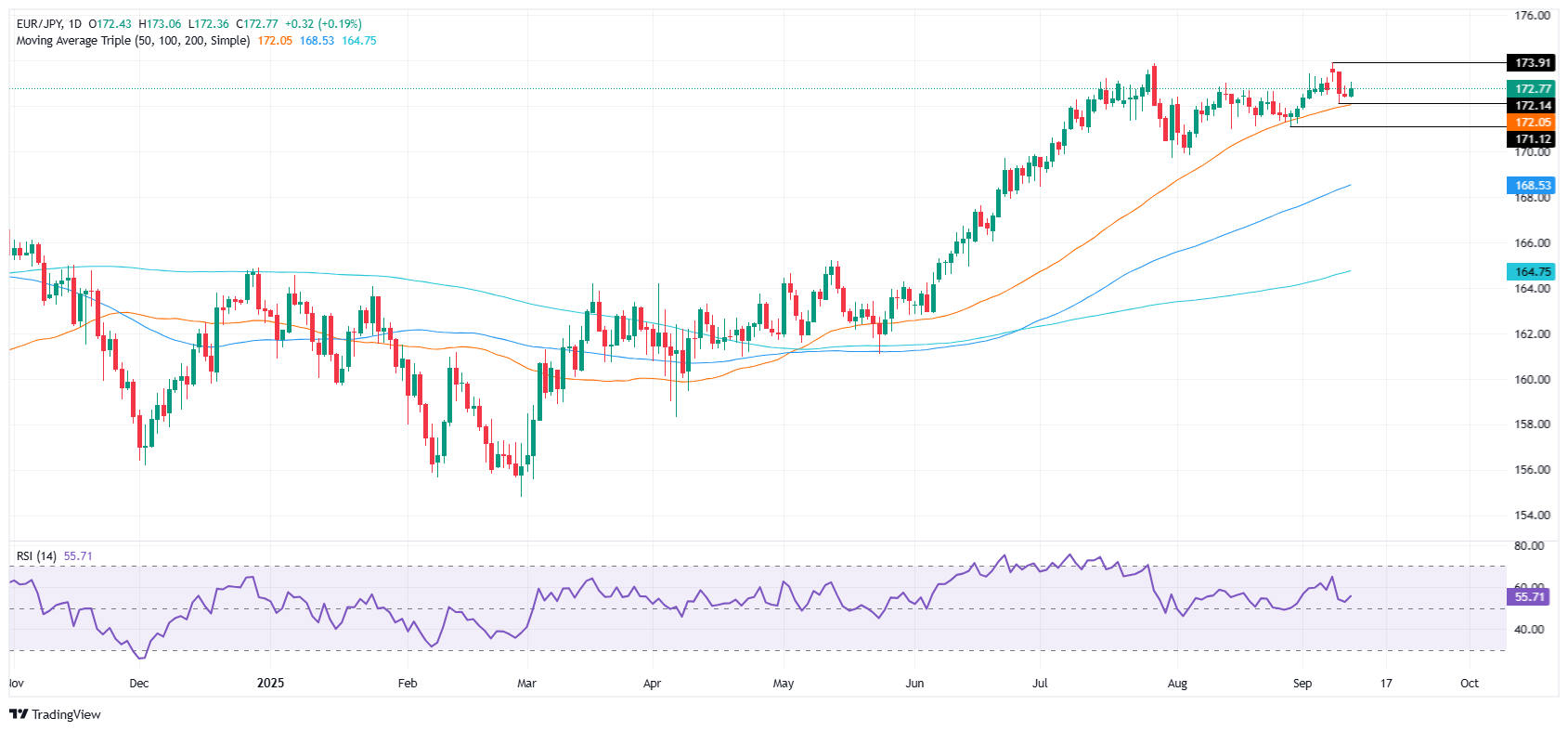EUR/JPY steadies at 172.65 as ECB hawkish hold offsets BoJ hike risks

- EUR/JPY peaks at 173.06 after ECB holds rates at 2% but Lagarde stresses unanimous stance and hawkish policy tone.
- Yen pressured by PM Ishiba’s resignation, though reports of potential BoJ hike cap EUR/JPY upside near 173.50s.
- Market pricing shows 62% chance of BoJ hold at 0.50% and 38% probability of 25 bps hike to 0.75%.
The Euro advances against the Japanese Yen during the North American session, up a modest 0.10% after the European Central Bank (ECB) held rates unchanged, as expected. Hawkish comments by the ECB’s President Lagarde, propelled the pair towards its high of 173.06, before retreating to current levels at around 172.65.
Euro trims gains despite Lagarde´s signaling end of disinflation; BoJ hike speculation weighs
The ECB kept the Deposit Rate at 2% as widely expected, with the statement showing that the Governing Council (GC) would decide adjustments to its policy in a meeting-by-meeting and data-dependent approach. The GC revealed that they are not on a pre-committed path on rates.
After that, ECB’s President Christine Lagarde said that the disinflationary process is over, added that policy is in a good place and that today’s decision was unanimous. Furthermore, she commented that trade uncertainty has diminished and that risks to economic growth are tilted to the downside.
In the meantime, political turmoil in Japan following the resignation of PM Ishiba, pressured the Yen. Nevertheless, source reporting that the Bank of Japan (BoJ) is considering rising rates this year, tumbled the EUR/JPY from around 173.50s toward 172.10.
BoJ Governor Ueda was hawkish last week, saying that the BoJ would raise rates if there are improvements in Japan’s growth and inflation backdrop in line with the bank’s outlook.
The Prime Market Terminal interest rate probability tool shows that market participants had priced in a 62% chance for holding rates at 0.50%, while 38% expect a 25-basis points rate hike to 0.75%.
EUR/JPY Price Forecast: Technical outlook
The EUR/JPY trades near the lows of the week, but it has bounced off the 20-day SMA at 172.29 but struggled to decisively crack 173.00. From a price action standpoint, if sellers drive the exchange rate below 172.00, this will expose the August 28 low of 171.12 ahead of the 171.00 figure. The Relative Strength Index (RSI) is bullish, but in the short-term signals that the cross-pair might be headed for a retracement.
On the other hand, if EUR/JPY recovers 173.00, buyers could challenge the September 8 high of 173.91.

Euro Price This week
The table below shows the percentage change of Euro (EUR) against listed major currencies this week. Euro was the strongest against the Canadian Dollar.
| USD | EUR | GBP | JPY | CAD | AUD | NZD | CHF | |
|---|---|---|---|---|---|---|---|---|
| USD | -0.23% | -0.46% | -0.74% | 0.05% | -1.46% | -1.17% | -0.36% | |
| EUR | 0.23% | -0.24% | -0.45% | 0.27% | -1.22% | -0.90% | -0.13% | |
| GBP | 0.46% | 0.24% | -0.28% | 0.51% | -0.98% | -0.66% | 0.11% | |
| JPY | 0.74% | 0.45% | 0.28% | 0.73% | -0.76% | -0.58% | 0.40% | |
| CAD | -0.05% | -0.27% | -0.51% | -0.73% | -1.41% | -1.15% | -0.40% | |
| AUD | 1.46% | 1.22% | 0.98% | 0.76% | 1.41% | 0.33% | 1.11% | |
| NZD | 1.17% | 0.90% | 0.66% | 0.58% | 1.15% | -0.33% | 0.78% | |
| CHF | 0.36% | 0.13% | -0.11% | -0.40% | 0.40% | -1.11% | -0.78% |
The heat map shows percentage changes of major currencies against each other. The base currency is picked from the left column, while the quote currency is picked from the top row. For example, if you pick the Euro from the left column and move along the horizontal line to the US Dollar, the percentage change displayed in the box will represent EUR (base)/USD (quote).







